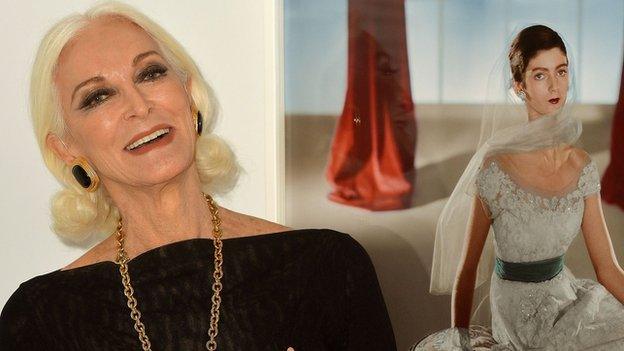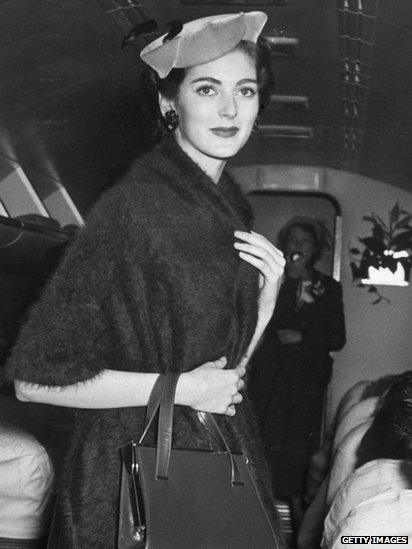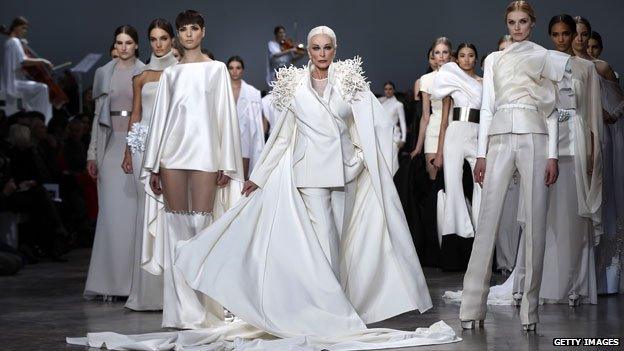Carmen Dell'Orefice: model, muse and memorable handshake
- Published

As first impressions go, it was an odd one. I've experienced numerous handshakes over the years, from the 'damp rag' to the 'bone crusher', but I've never had the 'forearm grip' before. It was disconcerting.
Maybe if I'd been meeting an all-in wrestling champ or a dude from the hood I'd have been less taken aback, but I wasn't - I was proffering a welcoming hand to a highly sophisticated and extremely elegant 83-year old American fashion model called Carmen Dell'Orefice.
I look at her quizzically.
"Err, why the weird handshake Ms Dell'Orefice?"
"It's so I don't have to touch the germs on your hands," she says, and smiles.
Golly. Really? It strikes me that there are probably quite a few holes in her logic, but none seem worth pursuing. After all, life would be a dull affair if you weren't allowed to be a little quirky when in your eighties. Or, for that matter, take the conversation where you please.
I am mid-way through a question about Horst - the legendary 20th Century fashion photographer for whom she was a muse, and whose exhibition at the V&A we are going around together - when Carmen spots a long lost image by the master.
"That's me!," she announces and points an erect finger over my shoulder.

Carmen Dell'Orefice pictured in 1955
She sets off towards the black & white photograph at an admirable speed (I later learn that she has recently had two knee-replacements, making her gallivanting about the gallery all the more remarkable: a tribute to her physical robustness and New York's orthopaedic surgeons).
"I'm so thrilled to see this picture!," she says, with the kind of genuine warmth one might greet an old friend.
It shows her in silhouette on a stage set designed by Salvador Dali, with whom Horst had struck up a friendship. It was taken in 1947 when she was sixteen-years old. It was, she says, the first time she met Dali.
"How did he treat you?"
"Oh, I was just a kid. He joked around. I sat for him many times afterwards; we become great friends and remained so until the day he died."
"Did you get paid for modelling?"
"$7.50 an-hour. Better than taking the lids off Coca-Cola bottles," she says as if the two occupations were comparable, which, I guess, they were to her at the time.
Carmen was a bright child from a poor household, up for any odd jobs that would help her parents out financially. That she ended up being a fashion model was down to a spot of good fortune.
Her father was a keen jazz musician and agreed to let his then fourteen-year old daughter join one of his regular jamming soirees. She sat by her father's feet as he and his friends played, while others looked on. Among the audience at the informal gathering was a well-connected member of Manhattan's fashion crowd, who thought the gangly teenager with a mouthful of braces had a look that might prove photogenic.
A couple of weeks later, the callow Carmen found herself at the Vogue studios, 480 Lexington Avenue, New York, being photographed by Conde Nast's finest. Cecil Beaton, Irvine Penn and Serge Balkin all wielded their cameras before her, as did the ex-pat German, Horst. For her, this was a chance to dress up and play the adult: it was a game. For the photographers - particularly Horst- it was a chance discovery of a fresh young talent ideally suited to their fresh young industry.
The youngster was pliable, intelligent and responsive: an ingenue who instinctively understood that a model that can tell a story through posture and attitude was of far more use to the photographers shaping the aesthetic for America's nascent fashion business than one who was simply beautiful.

The model is still in demand for shows across the world, pictured here in Paris
I want to take a look at those first black and white pictures Horst took of her in 1946 when she was a boyish-looking fifteen year-old with heavy eyebrows, poised for a facial.
"Let's," she says. But as we walk towards those early images she asks if there are any colour photographs in the exhibition.
"Yes," I say, "towards the end of the show."
This is a mistake.
"Where?," she asks 'This way?" She gestures to the right, the black & whites are on the left.
"Yep, that way," I say, and tag along.
We arrive at a gallery full of large colour images hung in white frames on a white wall background.
"Wow, these images really pop!," she exclaims. And then…
"That's me!"
And there she is, in a splendid, close-fitting evening dress, sitting demurely on a low, round rococo stall, framed by two huge blood-red velvet curtains that hang either side of a giant Georgian window. The vibe is Vivien Leigh in Gone with the Wind.
"I wouldn't recognise you," I say, rather more bluntly than I had intended. I hadn't meant it in a "Crikey, you've gone off luv," sort of way - she still looks terrific - but I fear that is how it was taken. She looked a little hurt, and a bit nonplussed.
I explain that it's her mouth that seems so different. She says that she had to keep it tight shut to hide her braces and that the lipstick had been applied to make her mouth look pinched. And then, after looking at the photograph a while longer, she says, "it's as if I'm meeting her for the first time".
"Do you remember it being taken?"
A pause.
"Yes. Yes, I remember almost all my pictures."
"What made Horst special?"
"He loved women. The man trained as an architect. He saw shape and form and dimension. He understood and controlled light. He helped women describe themselves to the rest of the world."
Carmen was a model before modelling became a structured profession with limos and agents. Conde Nast booked her for an assignment by sending a boy around to her parents' apartment with a note. She'd read it, tell her mother where she was going, put on her roller skates and head to the studio with her cocker spaniel in tow.
Soon she had made enough money to support her mother, with whom she would spend evenings altering dresses for the other models to wear. She had no idea that she was part of a history being made, nor did she have any notion that she was glamorous - she was just a teenager having fun.
It's nearly seventy years later and she's still having fun, and has lost none of her natural modesty. She talks of her career in a matter-of-fact way, never taking credit for her achievements, giving it instead to the photographers or her mother. She's not fancy or imperious or in any way arrogant. She is, I expect, in many respects very much like her fifteen-year old self: smart, uncomplicated and generous.
Lovely woman, memorable handshake.